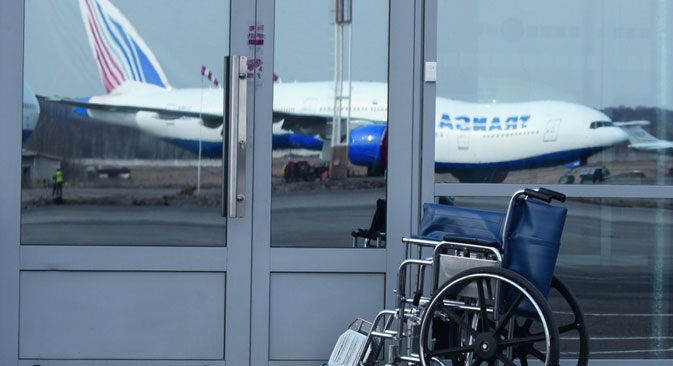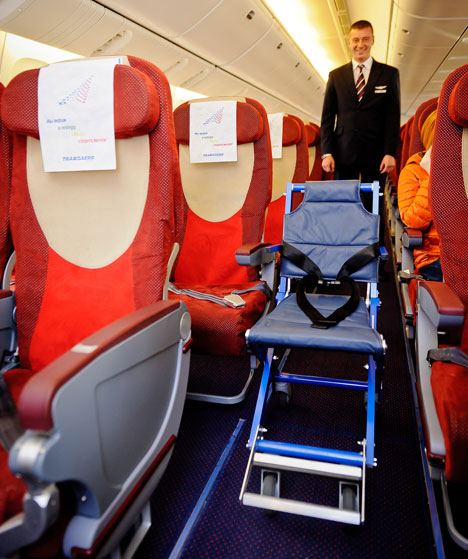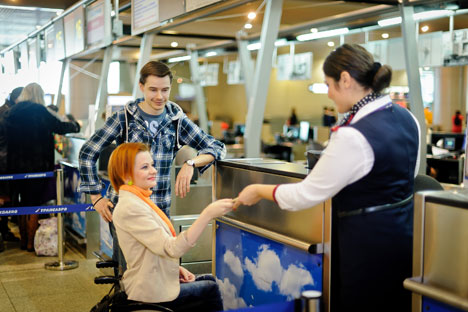
Passengers can seek assistance from airport staff, such as requesting an escort through the airport, or a special wheelchair so that they can be lifted on board. Source: Press photo
Some 14.5 million people, or nearly 10 per cent of the population, in Russia are disabled, according to statistics. According to Natalya Ulyanova, General Director of the charity Paralis, 30 per cent of disabled people are active and engage in business or politics, and travel. A further 30 per cent are potential tourists, who are ready to travel if their requirements are met.
“Disabled people in Russia are presented with a psychological barrier,” says Georgiy Bezborodov, one of the founders of the Baryerov Nyet (No Boundaries) project, an interactive map that highlights facilities with wheelchair ramps. “If disabled people are aware that all the prerequisites are in place for their mobility, they will feel more confident and will actively go beyond the boundaries of their home, either to visit friends or to travel.”
Bezborodov adds that many Russian airports have undergone reconstruction, so there is no shortage of wheelchair ramps. Oleg Panteleyev, head of analysis at the Aviaport agency agrees. “All airports are taking steps to ensure that disabled people are able to use the services at an airport hub either independently or with the assistance of airport staff,” he says. “Signs are being written in a special script, and dedicated services are being set up in which staff assist passengers with special needs through all the formal procedures.”
Passengers can seek assistance from airport staff, such as requesting an escort through the airport, or a special wheelchair so that they can be lifted on board, by calling the contact centre of the airline they are travelling with or at the check in desk. A member of airport staff will accompany a passenger until they board the plane, assisting them to complete all the pre-flight procedures.
If a boarding gate is used to board the aircraft a disabled person can gain access using a wheelchair. If not then a disabled person can be lifted on board the aircraft using an ambulift with the assistance of a member of airport staff.
However it is not enough to put all the requirements in place to ensure comfortable travel for disabled people at the airport alone.
“A barrier-free environment is a unified set of measures and all service companies have a role to play in bringing this to fruition. Apart from that, it is important to consult experts from non-commercial organisations aimed at improving the quality of life for disabled people,” explains Elena Zhuravleva, Director of Social Policy at Transaero Airlines.

The main problem on board an aircraft is the limited aisle space between the rows of seats. Source: Press photo
Bezborodov says the main problem on board an aircraft is the limited aisle space between the rows of seats, which cannot accommodate a standard wheelchair. Panteleyev thinks that “the most sensible way out of this situation is to use special narrow wheelchairs. However, airlines need to invest to purchase them”.
Zhuraleva says: ‘A passenger cannot move along the aisles in an aircraft in a standard wheelchair. To solve this problem Transaero has purchased special wheelchairs for moving around the aircraft, and they can be used on any type of airliner.”
Airport staff can assist a disabled passenger to transfer to the special wheelchair, and flight attendants can look after the passenger on board. But introducing foreign experience in serving disabled passengers into Russia is fraught with difficulties due to a lack of benchmark standards in the country.
As Panteleyev explains, there are no special training centres in Russia approved by Rosaviatsiya, the state aviation body, where flight attendants can learn how to serve disabled people. Non-governmental organisations that campaign for the interests of disabled people perform the function of the state.

Airport staff can assist a disabled passenger to transfer to the special wheelchair, and flight attendants can look after the passenger on board. Source: Press photo
“In developing service standards, the airlines are reliant on the experiences of those who use their service. They therefore work with large non-governmental organisations such as the Vserossiyskoye Obshchestvo Invalidov (the All-Russian Society for Disabled People), Vserossiyskoye Obshchestvo Slepykh (the All-Russian Society for the Blind), and the Organizatsiya Invalidov ‘Perspektiva’ (the ‘Perspektiva’ Organisation for Disabled People),” explains Zhuravleva. ‘We train our staff and develop service standards with advice from the experts’.
According to the Transaero representative, the airline is the first Russian carrier to pay particular attention to issues of transport accessibility for physically disabled people. She says: “The company has been implementing a programme to create a barrier-free environment for these passengers since 2008.”
One of Transaero’s brightest initiatives, carried out with the support of non-governmental organisations, was a special flight for disabled fans for the opening of the Paralympics in Sochi. A Boeing 777 carried 100 disabled sporting fans, 20 of whom used wheelchairs, at the beginning of March. Zhuravleva emphasised that “sports fans from cities all over Russia were given the opportunity to fly to the world’s largest Paralympic competition in the most comfortable conditions”.
Read more: Russia's airline company launches charity projects for children
All rights reserved by Rossiyskaya Gazeta.
Subscribe
to our newsletter!
Get the week's best stories straight to your inbox